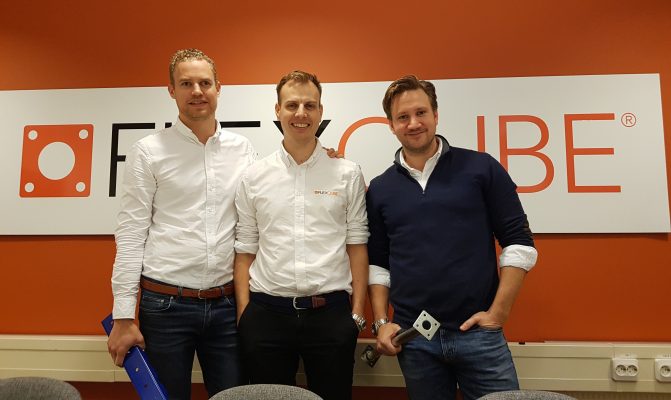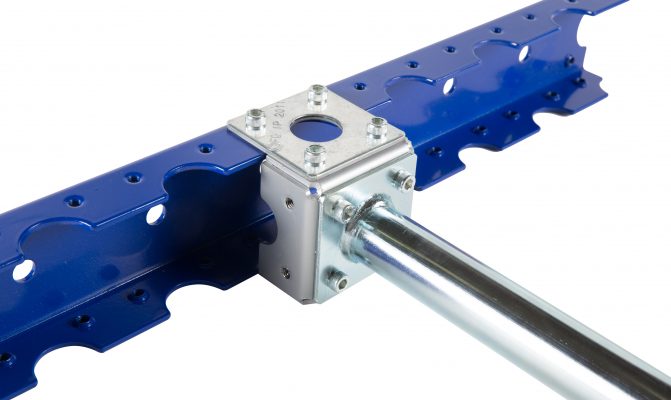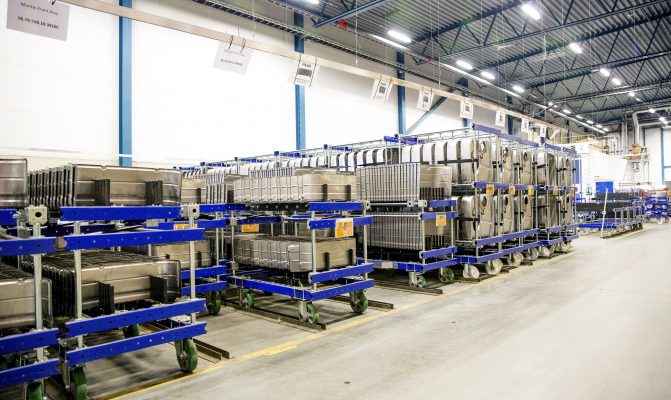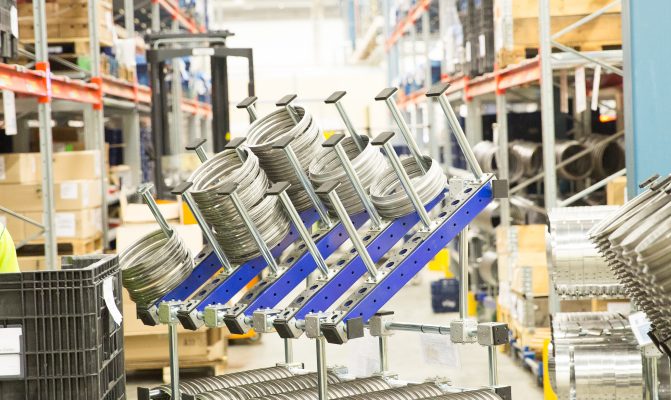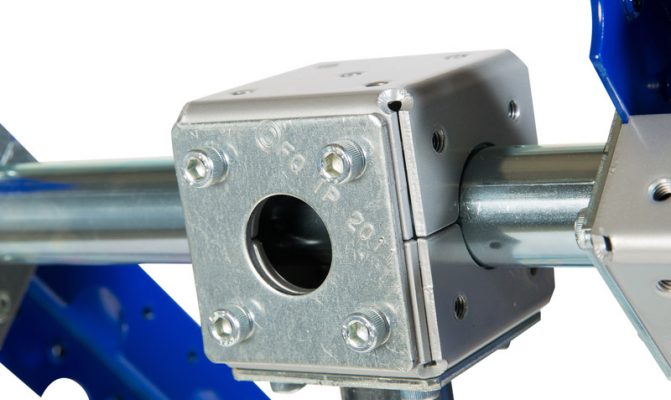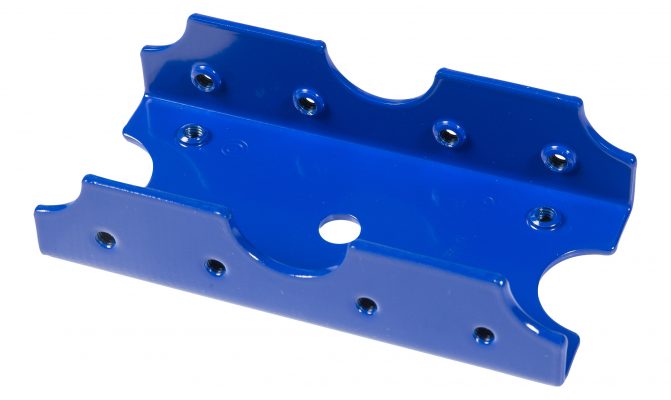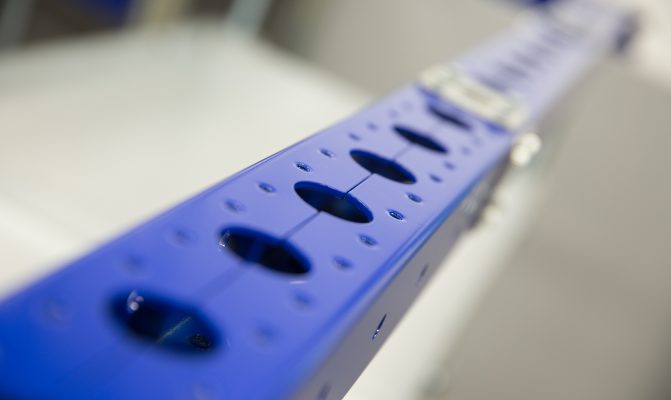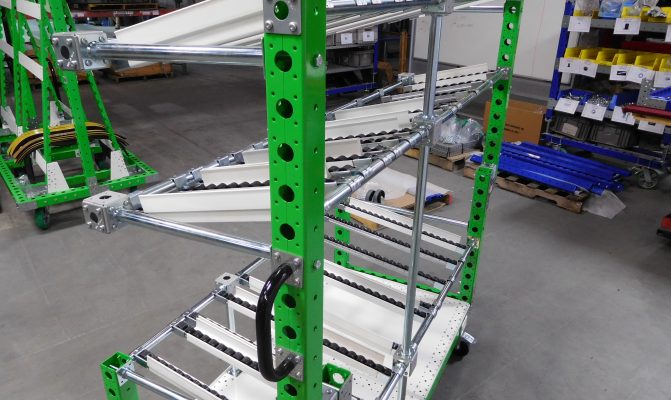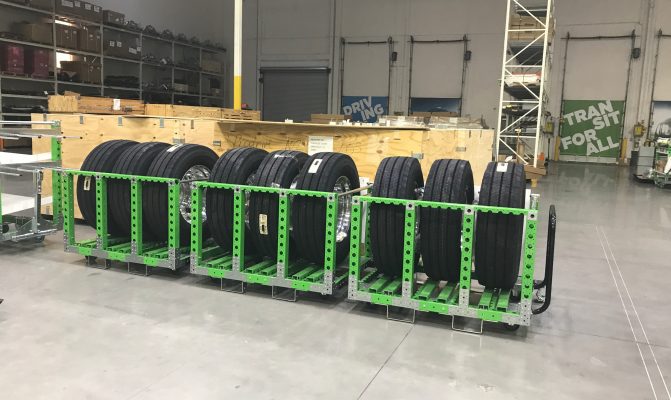Child’s play: Inspired by Lego, the founders of Gothenburg based FlexQube aim to make their customers best in the world at intralogistics with their flexible yet simple solution
When working for a world leading manufacturer for construction equipment, Per Augustsson noticed that the material management was quite static. Welded solutions were used to aid the manufacturing process, whereas the production material and its dimensions were continuously changing. A trolley used for carrying a certain piece of metal from the warehouse to the production line had to be specifically designed to fit the piece in question and support its specific weight. When that certain piece of metal was replaced with another, i.e. to fit a new model, the trolley had to be discarded.
As the material changed increasingly more frequently, new production aids had to be manufactured accordingly.
“There was a definite need for flexibility,” says Christian Thiel, Head of Finances at FlexQube.
Industrial Lego
After considering alternatives, which could offer a robust solution with a longer life-span, Per came up with a new concept together with Christian and Anders Fogelberg (now CEO) in 2010: the industrial equivalent to Lego.
“Our product is inspired by Lego. We use intervals of seven centimetres in all components so you can easily assemble them into different constructions. Regardless of how you interlock our products, you get the same interface – just like with Lego,” says Christian.
One of the first steps was to make sure that the prototypes were patented. To guide the newly found company along way, they had Patent Attorney Joacim Lydén from Awapatent.
“You have to start at the right end and take your Intellectual Property seriously. I see many start-ups who think that patents and trademarks come in at a later stage in the process, when it really should be one of the strategic building blocks for the company,” says Joacim.
“It is never too soon to look into your IP.”
Christian agrees:
“My background is partially within law, so I knew how crucial it was to sort our IP as soon we started out. Together with our IP partner Awapatent, we developed a strong IP strategy which has helped us in many ways.
“One motivation was of course to protect our idea, but as an underdog on a fierce market, it was also important to look professional and be taken seriously by our competitors and customers.”
We have always had a global mindset and strategy at FlexQube, focusing on where our potential clients are. This is something I would recommend other start-ups as well: Don’t be afraid to think big from the get-go.-Christian Thiel
Ticks more than one box
The concept, which was named FlexQube, has more than one benefit.
Using the system is more cost efficient than traditional welded solutions, as you have a suitable system for different situations; more time efficient as you simply rebuild the components without any welding involved; and more environmentally friendly as FlexQube uses less steel than a welded solution and reuses it. In addition, with FlexQube it is easy to replace a damaged component whereas you usually must discard the entire welded equivalent.
FlexQube ticks yet another box by offering an ergonomic solution in the workplace.
“You can easily adapt the construction to fit different weights or heights in order to alleviate the stress on the human body,” says Christian.
Despite its flexibility, FlexQube is an extremely robust and resilient system according to Christian.
“It can handle heavy impact.”
FlexQube’s USPs
The FlexQube Solution Library is an interactive online resource for FlexQube’s customers offering construction solutions and inspiration.
“We have around 1000 different solutions covering most areas, but we can also design on demand meaning we offer bespoke solutions in a web meeting with the customer. With speedy deliveries and easy assembly, customers get the solutions they need – fast.”
Customers can also upload their own constructions to the Solution Library, for others to use.
In the manufacturing segment, an important Unique Selling Point for FlexQube is to offer one concept which works everywhere.
“Global companies with factories across the world usually buy from their local market. If they have, let’s say, 50 factories but 30 different suppliers of the same product because they buy locally, it is a fragmented market. What we want to offer is one concept for global customers.
“We wanted to build this structure from day one, as we could spot a gap in the market.”
Another trigger for FlexQube’s customers is the easy-to-grasp solutions with step-by-step instructions.
“It is very easy to start production in new locations to shorten the transport distances as we can offer solutions which are easily spread out throughout the organisation and to manufacturing hubs. In comparison to welded solutions, where you must have centralised expertise in each manufacturing hub, our concept makes expansion simple.”
From market to market
The manufacturing hubs of FlexQube are located in Torsby, Sweden, for the European market and in Georgia, Atlanta, for the North American and Mexican market.
“Our biggest market is the US. The threshold has been lower there, largely due to the language which obviously facilitates the communication, but we have also encountered a different curiosity and openness to new ideas in the US. Among other investments, we are currently considering expanding in the US with a manufacturing hub on the West Coast.
After the US, FlexQube’s main clientele is in Sweden and Mexico.
“To begin with, we didn’t realise how big of a market that Mexico would be. But incredible investments are being made and new factories are being built in Mexico today, which means that they need these kind of solutions.
“We have always had a global mindset and strategy at FlexQube, focusing on where our potential clients are. This is something I would recommend other start-ups as well: Don’t be afraid to think big from the get-go.”
The biggest industry represented amongst their clients is automotive manufacturing, e.g. excavators, heavy lorries, and agricultural machines. But FlexQube also provides solutions for windmills, white goods, and consumer products, to mention but a few. Well-known companies such as Whirlpool, Siemens, Volvo Cars and Cummins can be found on their list of customers.
Add-ons and updates of FlexQube’s products parallel to the customers’ own change, mean that their customers keep on coming back for more components to optimise their logistic solutions.
“We usually sell almost twice as much to a customer in the second year as we do in the first. Historically we see in general that a customer increases their purchases for every year they are a customer. In short, we have a pretty decent sales curve.”
Better all time
As of mid-December, FlexQube will be listed on Nasdaq First North as a step towards continuing its expansion, widen its offer and increase brand awareness.
“We always strive to get even better at what we do. As for the people behind FlexQube, we all have an entrepreneurial spirit which I would say is reflected in the work and ideas we produce”, says Christian.
“We are driven by the fact that we have a bloody brilliant product which we believe many are in desperate need of. Our mantra is to make our customers world leaders in intralogistics.”
FlexQube
For more information on FlexQube, please visit flexqube.com
For their IP matters, FlexQube has been consulted by Joacim Lydén at Awapatent’s Malmö Office.

